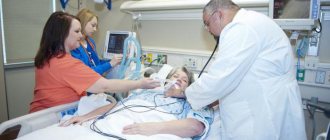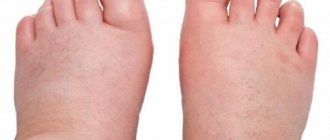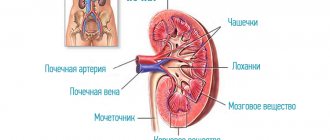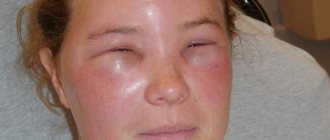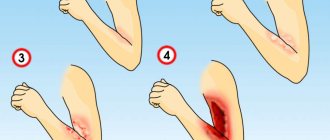Almost every doctor in his practice encounters the so-called angioedema, or Quincke's edema. Doctors at our hospital are also no exception: quite often patients with the specified nosology are admitted to the inpatient emergency department.
This disease was first described in 1586. The German physician Heinrich Quincke described it in detail in 1882. In this regard, in various medical literature we can often find this disease called “Quincke’s edema”.
Angioedema, or Quincke's edema, is a reaction to the influence of various biological and chemical factors.
Epidemiology
The World Allergy Organization notes that urticaria and angioedema affect up to 20% of the population. She estimates that approximately 10-20% of the population may experience at least 1 episode of angioedema during their lifetime.
About 40-50% of patients with chronic urticaria have a history of episodes of angioedema and about 10% have only clinical signs of angioedema. About 1% of the population suffers from chronic urticaria. Given these data, up to 0.5% of the population suffers from chronic or recurrent angioedema.
Pathophysiology
Angioedema is swelling of the deep layers of the dermis and subcutaneous tissues due to increased vascular permeability and effusion of intravascular fluid.
Known mediators of increased vascular permeability are:
- mast cell derivatives (eg, histamine, leukotrienes, prostaglandins)
- Bradykinin and mediators, derivatives of the complement system
Mediators derived from mast cells also tend to affect the superficial layer of subcutaneous tissue. Here, the mediators cause the urticaria and pruritus that typically accompany mast cell-mediated angioedema. In angioedema mediated by bradykidin, urticaria and itching are absent.
Angioedema can be of acute or chronic type (lasting more than 6 weeks). This disease has hereditary and acquired forms.
Etiology
More than 40% of chronic angioedema is idiopathic. Sometimes the cause is chronic use of benign drugs or other synthetic products (eg, penicillin in milk, over-the-counter drugs, preservatives, other food additives). Trauma, surgical procedures, and stress are common nonspecific triggers for attacks of angioedema.
Common causes of angioedema are:
- Hypersensitivity (for example, to food, medications (most often ACE inhibitors and NSAIDs) or insect bites). ACE inhibitors are the cause of acute angioedema observed in emergency departments in 30% of cases. ACE inhibitors directly increase bradykinin levels. In this case, urticaria does not occur. Angioedema may occur soon after starting medications or years after starting therapy.
— Physical stimuli (for example, cold or vibrations)
— Autoimmune disease or infection
— Hereditary factors
Demographics
Angioedema occurs in all age groups. In individuals predisposed to angioedema, there is a tendency for the frequency of attacks to increase after adolescence, with a peak incidence occurring in the third decade of life. There has been a continuous increase in the rate of hospitalization for angioedema (3% per year). Hospitalization rates are highest among those aged 65 years and older.
Allergic reactions to food are more common in children. The average age of angioedema caused by ACE inhibitors is 60 years.
Chronic idiopathic angioedema is more common in women than in men. Other types of angioedema do not show a strong sex preponderance.
There is no specific racial predisposition to angioedema. However, black people are more “sensitive” to ACE inhibitors.
Forecast
The prognosis for patients with angioedema depends on the etiology and is determined as follows:
Angioedema with identifiable causes - if the trigger(s) can be identified and avoided, angioedema can be prevented.
Angioedema without identifiable causes has an extremely variable clinical course. The course ranges from mild to severe, duration ranges from several days to many years; the response to traditional treatment is less unpredictable. In the chronic version of the disease, lifelong drug treatment is often necessary.
Acute angioedema
Acute angioedema is mast cell mediated in >90% of cases. Mast cell-mediated mechanisms are usually accompanied by acute urticaria (localized blistering and swelling of the skin).
Clinical manifestations
Angioedema is often asymmetrical and mildly painful. Particularly susceptible to swelling are the areas of the eyelids, lips, face, tongue, as well as the backs of the arms and legs, and genitals. Swelling of the upper airways can cause respiratory distress and stridor, which is sometimes mistaken for asthma. Complete airway obstruction may occur. Swelling of the intestinal lining can cause nausea, vomiting, painful abdominal cramps and/or diarrhea.
- May develop within minutes or over several hours
- May be accompanied by manifestations characteristic of allergic reactions (for example, itching, urticaria, hyperemia, bronchospasm, anaphylatic shock)
What is angioedema?
Angioedema, or Quincke's edema, is not a disease.
This is an acute allergic reaction that occurs as a result of contact of the body with an allergen and is accompanied by swelling of the skin, subcutaneous tissue and mucous membranes. According to statistics, from 10 to 20% of the world's population have experienced angioedema at least once in their lives [1].
After contact with an allergen, specialized molecules are released in the blood - inflammatory mediators. They act on the walls of blood vessels, increasing their permeability. As a result, vascular fluid penetrates into the subcutaneous fatty tissue and mucous membranes, causing their swelling.
Publications in the media
Angioedema is an acutely developing, rapidly passing swelling of the skin and subcutaneous tissue or mucous membranes. Etiology. Angioedema is a polyetiological disease that can be caused by both immune and non-immune factors.
• Allergic - manifestation of an allergic reaction of type I; develops as a manifestation of sensitization to drugs (usually antibiotics), food products and additives, and the venom of stinging insects (bees, wasps and hornets). • Pseudoallergic - as a result of the direct non-immune histamine-releasing action of certain drugs (salicylates and other NSAIDs, ACE inhibitors, dextrans, etc.), foods or additives (see Food allergy). • Complement-dependent - can be inherited or acquired (usually in patients with lymphoproliferative malignancies, which is associated with an acceleration of the metabolism of the complement component esterase inhibitor C1 by 2-3 times). • Idiopathic - etiology is unclear.
Risk factors • Atopic predisposition • Taking ACE inhibitors (in 0.2% of cases) • Presumably taking omeprazole (proton pump inhibitor) and sertraline (selective serotonin reuptake inhibitor). Genetic aspects. Hereditary angioedema (*106100, complement C1 esterase inhibitor deficiency, 11p11.2–q13, C1NH gene deletion in type 1, point mutation in type 2, ) is characterized by recurrent episodes of swelling of the skin, upper respiratory tract and gastrointestinal tract (up to to intestinal obstruction). • C1q inhibitor is a highly glycosylated serum protein synthesized in the liver and inhibits the proteolytic activity of the C1r and C1s subcomponents, thus preventing the activation of the C4 and C2 complement components. • Insufficiency of the C1q inhibitor leads to uncontrolled activation of early complement components and the formation of kinin-like factor, which causes an increase in vascular permeability and leads to the development of angioedema. • Most often (in 80–85% of cases) the cause of hereditary angioedema is a quantitative deficiency of the C1q inhibitor (type 1); in other cases, with a normal amount of inhibitor, the cause of hereditary angioedema is its functional inferiority of the C1 inactivator due to a point mutation in the reactive center molecules (type 2).
The pathogenesis is similar to the pathogenesis of urticaria and is associated with dilatation and increased permeability of blood vessels (mainly venules) of the deep (unlike urticaria) layers of the dermis and submucosal layer, caused by allergic mediators (histamine, Pg, leukotrienes), as well as complement components (primarily C3a and C5a) and kinins.
Pathomorphology. Edema, vasculitis and/or perivasculitis involving only subcutaneous tissues. Clinical picture • Local swelling of the skin, subcutaneous tissue and/or mucous membranes in combination with or without urticaria • Often - an integral component of a generalized anaphylactic reaction (anaphylactic shock) • Can develop in any part of the body; The usual localization is the face (usually lips, eyelids), limbs, external genitalia. The greatest danger to life is edema of the larynx and the asphyxia caused by it • Rapid onset and rapid spontaneous resolution • Characterized by a feeling of numbness, itching, much less pronounced compared to urticaria.
Laboratory tests • In the allergic form - determination of IgE using a radioallergosorbent test (primarily with allergies to penicillin, as well as food allergens) • Determination of the levels of C1q inhibitor, as well as C2 and C4 complement components in hereditary angioedema •• Reduction of the level of C1q inhibitor below 100 mg/ml in type 1 •• Decrease in C4 in both types 1 and 2 •• C2 is reduced during exacerbation in types 1 and 2 •• In patients with acquired forms of C1-inactivator deficiency, C1 is also reduced (unlike congenital forms).
Differential diagnosis • Diffuse subcutaneous infiltrative process • Contact dermatitis • Lymphostasis (lymphatic edema) • Thrombophlebitis • Local edema in somatic pathology • Granulomatous cheilitis • Erysipelas with severe edema • Cellulitis.
TREATMENT Diet . Elimination of known food allergens (egg whites, milk and wheat, fish, nuts, tomatoes, chocolate, bananas, citrus fruits) up to the transition to a basic hypoallergenic diet. Management tactics • Protection from exposure to known triggers • Cold compress to reduce the intensity of itching • Intubation for upper airway obstruction. Drug therapy . Drugs of choice - see Urticaria. Extra caution! Angioedema of the larynx and the asphyxia caused by it are potentially life-threatening and require active therapy • Epinephrine 0.3 ml 0.1% solution subcutaneously, as well as locally in the form of an aerosol • GC - dexamethasone 4–8 mg IM or IV, or 30–60 mg prednisolone; in hereditary angioedema, the effectiveness of GC is questionable • Antihistamines - dimethindene IV, diphenhydramine, clemastine IM 1-2 ml.
Complications . Asphyxia caused by airway obstruction. Current and prognosis . Most patients with angioedema have little general impairment, except in cases of airway obstruction. In chronic forms, the course and prognosis depend on the etiology and pathogenesis.
Concomitant pathology • Anaphylaxis • Urticaria. Prevention • Avoid contact with the causative factor • ACE inhibitors are contraindicated • Before performing procedures that can provoke the development of hereditary angioedema (dental interventions, intubation, endoscopy, etc.), danazol 200 mg 3 times a day is recommended 3 days before the procedure, and immediately before it - the introduction of 2 standard packages of fresh frozen plasma • For long-term prophylaxis: •• Danazol 200-600 mg daily for 1 month, then every 5 days for 5 days. Danazol is not effective in other forms of C1-esterase inhibitor deficiency; Contraindicated for children, pregnant women, nursing mothers, and for porphyria; may cause headache, weight gain, hematuria •• Aminocaproic acid 1 g 3 times a day.
Synonyms • Quincke's disease • Quincke's edema.
ICD-10 • T78.3 Angioedema • D84.1 Defect in the system
Causes of Quincke's edema
The main mechanism for the development of angioedema is allergic. In this case, a pathological reaction can be caused [3]:
- food products (highly allergenic foods such as eggs, whole milk, citrus fruits, nuts, chocolate, etc.);
- animal hair;
- plant pollen;
- insect bites;
- exposure to water, sunlight or cold temperatures (in susceptible individuals);
- medications (Fig. 1).
Figure 1. The most common human allergens.
Source: inspiring / freepik.com The cause may also be a genetic predisposition (hereditary form of angioedema), autoimmune diseases, previous infectious diseases, as well as medications that cause angioedema as a side effect (for example, ACE inhibitors - angiotensin-converting enzyme inhibitors used in the treatment of arterial hypertension). hypertension)[1].
In some cases, the cause remains unclear.
Who is at risk for developing angioedema?
First of all, Quincke's edema threatens those who:
- suffers from any form of allergies;
- have already encountered angioedema before;
- has close relatives (parents, brothers, sisters) who have experienced severe allergic reactions;
- takes medications that can cause edema through a non-immune mechanism (ACE inhibitors, non-steroidal anti-inflammatory drugs and some others).
People at risk are advised to carry antihistamines with them to relieve an acute allergic reaction and understand the algorithm of actions in a stressful situation.
Symptoms
Quincke's edema affects various tissues of the body and internal organs. Most often it appears on the face or neck, less often on the upper body or genitals. Sometimes swelling affects the joints and digestive tract when allergens come in from food and medications. Damage to the respiratory organs or membranes of the brain is especially dangerous. Such serious complications as increasing suffocation and cerebrovascular accident develop. They can be fatal.
The rate of development of Quincke's edema depends on the amount of the allergen, as well as the duration of its exposure. The condition develops within a few minutes, and sometimes hours or days. Quincke's edema, which persists for more than 6 weeks, is classified as chronic. The swollen area is dense. When you press on it, a hole does not form. There is slight pallor of the skin. The main difference from other allergic reactions is the absence of itching and rash. Associated symptoms include:
- decreased blood pressure;
- cardiopalmus;
- increased sweating;
- confusion;
- lack of coordination;
- feelings of anxiety and fear;
- speech problems.
Symptoms of swelling of the trachea, bronchi and larynx include a sore throat, barking cough, difficulty breathing, redness or bluishness of the skin. The gastrointestinal form of edema is manifested by pain in the abdomen, nausea, vomiting and diarrhea. With cerebral edema, headaches and numbness in the back of the head occur, and there is a fear of light and loud sounds. Convulsions, paralysis, blurred vision and speech, nausea and vomiting may occur.
Classification: variants of angioedema
Despite the fact that angioedema always looks the same externally, there are several types depending on the cause that caused the swelling.
Allergic
This is a variant of Quincke's edema of an allergic nature - similar to other allergic reactions: dermatitis, urticaria, etc. After the body interacts with an allergen (it can be food products, pollen, animal fur), a cascade of pathological reactions is launched. Special protective proteins, immunoglobulins E (IgE), combining with antigen, affect mast cells and basophils and lead to the disintegration of their granules. Substances contained in the internal granules of basophils and mast cells (histamine, bradykinin, etc.) cause vasodilation, an increase in their permeability, swelling and itching.
Pseudo-allergic
This option includes several forms. They are not acute allergic reactions - IgE is not involved in the occurrence of edema.
Drug
In this case, the drug itself causes mast cell degranulation. This applies to such groups of drugs as angiotensin-converting enzyme inhibitors (ACEIs - they are often used in the treatment of hypertension), non-steroidal anti-inflammatory drugs, or NSAIDs, statins and some others. The range of uses of NSAIDs is wide - from pain relief to fever reduction.
Taking these medications does not mean at all that you will develop Quincke's edema. This is a pathological reaction that occurs extremely rarely. For example, among patients taking ACE inhibitors? only 1-5% are at risk for edema. For other drugs this figure is even lower[1].
Hereditary and acquired
These forms are characterized by disruption of the immune system. It can be either congenital or acquired (autoimmune diseases, various infections). As a result, angioedema can occur as a reaction to stress, exercise, or as a result of pregnancy. An imbalance of immune system factors leads to the fact that a pathological reaction develops in a situation that does not cause any disturbances in a healthy person.
Precursors of hereditary angioedema
Exactly when such swelling will develop can be difficult to predict. However, many patients report early signs of a negative immune reaction, which can appear several hours or even a day before the swelling. Among them:
- Fatigue.
- Weakness.
- Irritability.
- Nausea.
- The appearance of a pink rash, sometimes in the form of rings.
Idiopathic
In medicine, the term idiopathic means “independent of other lesions, of unknown cause.” For this form of Quincke's edema, it is impossible to determine the cause.
Flow forms
In addition to the forms that describe the origin of the edema, options can be distinguished depending on the duration:
- acute form - the duration of symptoms does not exceed 6 weeks;
- chronic form - symptoms persist for more than 6 weeks.
You can also describe different types of angioedema depending on the affected area.
Content:
- Risks from Angioedema
- Causes of the disease
- Manifestation of the disease
- Diagnosis of edema
- Treatment of Quincke's edema
Risks from Angioedema
Angioedema is a condition that occurs as a result of the action of an allergen or antigen, which triggers a local inflammatory reaction with swelling of the mucous membranes and subcutaneous tissue. Most often, this pathological condition develops quickly or even at lightning speed, somewhat less often it increases over several hours. The most dangerous include swelling of the larynx (this stops the supply of oxygen and death can occur), anaphylactic shock or status asthmaticus.
Causes of the disease
In most cases, the cause of angioedema is a type 1 allergic reaction - an immediate hypersensitivity reaction. Most often, such a reaction is observed to the poisons of stinging insects, medications or food ingredients. At their first contact with the immune cells of the body, specific antibodies are formed - Ig E, which are fixed on cells such as mast cells and basophils. When these substances re-enter the body, antibodies interact with the antigen or allergen and activate the above cells - biologically active substances are released from them: histamine, heparin, leukotrienes, bradykinin and others), which cause contraction of smooth muscles, swelling, increased vascular permeability and many other effects. Angioedema can also be pseudo-allergic - the release of the above substances occurs not according to the immune type, but as a result of the direct interaction of basophils and mast cells with antigens. For example, angioedema occurs quite often when taking drugs such as ACE inhibitors and angiotensin receptor antagonists. There are congenital complement-dependent Quincke's edema (deficiency of a complement inhibitor leads to increased activity of complement with increased formation of biologically active substances), angioedema from physical influence (vibration, from compression) and cold, as well as idiopathic (with an unknown etiology).
Manifestation of the disease
The clinical picture depends on the area in which the swelling develops, but several general criteria are identified: visible and palpable local swelling of the skin and mucous membranes or subcutaneous tissue appears (on the face, genitals, limbs, larynx) with itching and a feeling of numbness, which may be complicated by anaphylactic shock; the process is characterized by a rapid onset and an equally unexpected resolution of the process. Swelling of the skin and mucous membranes is accompanied by redness, local fever, itching and pain. With swelling of the larynx, symptoms such as a hoarse voice, soreness, difficulty swallowing and breathing, and a feeling of suffocation appear at an early stage. With swelling of the intestinal wall, pain, nausea, vomiting and diarrhea occur; with swelling of the wall of the bladder and urethra, urinary retention and pain when trying to urinate.
Diagnosis of edema
A doctor of any specialty should be able to diagnose and treat angioedema, but an allergist-immunologist will be able to determine the causes and, if necessary, prescribe preventive treatment and give recommendations for self-relief.
For diagnosis, in addition to characteristic complaints, it is necessary to identify factors in the anamnesis that could act as allergens or antigens, and conduct a physical examination to exclude complications. Additionally, laboratory diagnostics can be carried out to determine immunological parameters - the level of general and specific immunoglobulins, the level of complement and its fractions, prick tests and other allergy diagnostic methods.
Differential diagnosis should be carried out with diseases such as inflammatory infiltrative process, dermatitis, thrombophlebitis and other conditions.
Treatment of Quincke's edema
Treatment should include limiting the entry of the suspected allergen into the body; it is necessary to take an antihistamine or glucocorticoid orally or intramuscularly. If patients develop complications such as anaphylactic shock (spread of edema, drop in blood pressure, difficulty breathing, collapse), severe laryngospasm, intestinal edema, lack of effect from the treatment, the patient should be hospitalized in a hospital. Laryngeal edema requires the administration of the adrenergic agonist adrenaline, hydrocortisone and antihistamines to quickly relieve the condition and prevent asphyxia.
Symptoms of Quincke's edema
The main symptom of Quincke's edema is progressive swelling of the subcutaneous tissue of various areas.
Areas that may be affected:
- faces: forehead, eyelids, cheeks, lips, tongue, etc. (Fig. 2);
- scalp;
- neck;
- genitals;
- outer surface of feet and hands;
- arms and legs in the joint area.
Figure 2. Angioedema affecting the face, lips, tongue, arms and legs.
Source: International Journal of Emergency Medicine / Open-i (Attribution 4.0 International), Journal of pharmacology & pharmacotherapeutics / Open-i (Attribution-NonCommercial-ShareAlike 3.0 Unported), Anais brasileiros de dermatologia / Open-i (Attribution-NonCommercial 3.0 Unported ), Allergy, asthma & immunology research / Open-i (Attribution-NonCommercial 3.0 Unported), The Korean journal of internal medicine / Open-i (Attribution-NonCommercial 3.0 Unported). The skin above the surface of the edema may not be changed and be of normal color. In this case, there will be no itching. However, in 48% of cases[2], angioedema is combined with urticaria. With this option, there is itching, redness at the site of swelling, and blisters may occur.
Important! Quincke's edema tends to spread to neighboring organs and tissues. If swelling occurs on the face (eyelids, lips, tongue), special care should be taken, since the pathological process can affect the airways and cause breathing problems. If you notice sudden progressive swelling of your eyes, lips or tongue, you should immediately take an antihistamine and consult a doctor or call an ambulance.
Patients with angioedema may also be concerned about:
- spasmodic abdominal pain, nausea, vomiting - with swelling of the gastrointestinal mucosa (symptoms of such swelling can be confused with appendicitis or irritable bowel syndrome, the stomach may look bloated);
- difficulty breathing, changes in the sound of the voice, a feeling of a “lump” in the throat - with swelling of the airways.
Quincke's edema in children
External manifestations and symptoms in children do not differ from the symptoms of Quincke's edema in adults.
But some features of the child’s body (immaturity of the immune system, large specific mass of subcutaneous fat) can contribute to a more rapid spread of edema. In addition, in children much more often than in adults (in 93% of cases!), edema develops in the head area.[5] Therefore, emergency care must be provided to the child without delay to prevent breathing problems. As a rule, swelling in children is caused by an allergic reaction to a previously consumed product or medicine. However, parents often cannot name the exact cause of angioedema. Thus, many cases of angioedema in children can be avoided if you pay close attention to the child's diet, for example, keeping a food/medicine diary, especially when the child is allergic.
Quincke's edema: outpatient care
Sudden local edema, called angioedema (angioedema, giant urticaria), is encountered in the practice of a doctor of any specialty. They were first described in 1882.
The origin of this swelling may be different. They often appear as a result of contact with an allergen, that is, as a result of an allergic reaction (a reaction that occurs through immunological mechanisms). But Quincke's edema can also be of non-allergic origin (pseudo-allergic reactions). In this case, the edema reflects some other somatic pathology, most often various diseases of the gastrointestinal tract and hepatobiliary system. But in addition to gastroenterological pathology, the tendency to local edema is influenced by dysfunction of the endocrine system (or disorders of neuro-endocrine regulation), chronic foci of infection, tumor (Quincke's edema as a paraneoplastic reaction), systemic and some other diseases, and parasitic invasion. There are also edemas that appear under the influence of chemical (including medications) and physical (temperature, pressure, vibration) factors. Quite often, angioedema develops under the influence of several factors. There is hereditary vibration angioedema. Its mechanism is not clear; An increase in histamine levels was found after exposure to a vibration stimulus. The type of inheritance is autosomal dominant.
The general pathogenetic mechanism of any angioedema is a violation of the permeability of the microvasculature with the subsequent development of local edema.
The localization of edema can be different: face, mucous membrane of the oral cavity and gastrointestinal tract, larynx, external genitalia, parenchymal organs and meninges.
In most cases, edema is accompanied by urticaria (and angioedema itself can be considered as a deeper manifestation of urticaria), but they can also be an independent disease.
Another disease has a similar clinical picture - hereditary angioedema (HAE), which occurs as a result of congenital pathology - deficiency or functional inferiority of the inhibitor of the first component of complement.
Treatment for angioedema is carried out in 2 stages: the first is relief of the acute condition, the second is treatment of the cause of the disease. Treatment includes elimination of identified causative factors, symptomatic therapy, basic therapy and prevention of exacerbations (prevention of relapses of edema).
Localization of edema in the face, neck, oral cavity, and larynx can lead to asphyxia. Therefore, in such cases, treatment measures should be carried out quickly and efficiently. Difficulty breathing caused by swelling of the airways is a direct indication for hospitalization of the patient. The development of laryngeal edema may require emergency intubation or tracheostomy.
In addition, indications for inpatient treatment include intestinal edema, hypovolemia, failure of outpatient treatment, or the development of any life-threatening complications of angioedema. If there is no threat to the patient’s life, then treatment can be carried out on an outpatient basis.
The most commonly used drugs in the treatment of angioedema are histamine H1 receptor antagonists: fexofenadine in a dose of 60 to 240 mg 1-2 times a day; desloratadine - 5 mg/day; loratadine - 10 mg/day; cetirizine - 10–20 mg/day; ebastine - 10 mg/day; acrivastine - 8 mg 3 times a day; clemastine - 1 mg 2 times a day orally, 2 mg 2 times a day parenterally; chloropyramine - 25–50 mg/day orally, 20–40 mg parenterally; diphenhydramine - 30–50 mg 1–3 times a day orally, 20–50 mg 1–2 times a day parenterally; hydroxyzine - 25–50 mg every 6 hours; chlorpheniramine - 4 mg every 4-6 hours.
In more severe cases of angioedema, as well as when treatment with antihistamines is ineffective, a short course of parenteral treatment with glucocorticosteroids is administered: prednisolone - 40-60 mg/day, dexamethasone - 8-20 mg/day.
Further treatment of recurrent angioedema (second stage of treatment) will depend on the form of the disease.
Angioedema, occurring through the mechanisms of true allergy, requires unconditional elimination (exclusion) or limitation of contact with identified allergens in case of household, epidermal, pollen, food, occupational, drug, insect, fungal allergies. Otherwise, the treatment will be ineffective.
In the event of the appearance of angioedema resulting from exposure to physical factors, it is necessary to limit their effect on the patient: use photoprotective creams for angioedema due to insolation, avoid wearing heavy objects, tight shoes, use belts for edema resulting from pressure, avoid eating ice cream and other chilled drinks and foods for cold swelling, etc.
If the swelling is of non-allergic origin, then treatment is carried out after an in-depth clinical examination. It includes therapy for identified somatic pathologies (including rehabilitation of chronic foci of infection, such as tonsillitis, treatment of parasitic infestations, correction of intestinal dysbiosis, treatment of thyroiditis, diseases of the gastrointestinal tract and hepatobiliary system and other diseases that contribute to the development of pseudo-allergy). Such patients are prescribed a nonspecific hypoallergenic diet, which involves limiting the consumption of foods rich in histamine, tyramine, and histamine liberators (Table 1, 2, 3).
Symptomatic drug treatment of chronic, recurrent angioedema is also carried out with antihistamines. With a weak response to H1 receptor antagonists, the following are added to therapy: histamine H2 receptor antagonists (ranitidine - 150 mg 2 times a day, cimetidine - 300 mg 4 times a day, famotidine - 20 mg 2 times a day); leukotriene receptor antagonists (montelukast - 10 mg/day); calcium channel blockers (nifedipine - 20–60 mg/day).
For angioedema associated with systemic connective tissue diseases, drugs used in rheumatology (hydroxychloroquine, dapsone, colchicine, sulfasalazine) may be effective.
Treatment of hereditary angioedema is fundamentally different from the treatment of angioedema. Unrecognized HAE and, accordingly, inadequate therapy in many cases result in death. Diagnostic differences between HAE and allergic edema are presented in Table 4.
In the acute period, HAE is relieved by the administration of fresh or fresh frozen native plasma (replacement of C1 inhibitor deficiency), intravenous administration of tranexamic or aminocaproic acid. Danazol 800 mg/day (or stanozolol 12 mg/day) can also be administered. For swelling in the face and neck, furosemide (Lasix) and dexamethasone are additionally administered intravenously.
All patients with angioedema must have an “allergy patient passport” or a medical bracelet with information about the disease.
For questions regarding literature, please contact the editor.
S. V. Tsarev , Candidate of Medical Sciences, State Research Center Institute of Immunology, FU Medbioextrem, Ministry of Health of Russia, Moscow
Table 1. Products that can provoke angioedema
| Foods containing histamine-releasing substances | Foods rich in biogenic amines |
| Chocolate, strawberries, citrus fruits, tomatoes, crustaceans and oysters, coriander, pork, fish, alcohol, nuts, peanuts | Chocolate, sauerkraut, ham, stale cheese, fermented cheese, red wine, beer, fish, sausage; there is a lot of histamine in overripe and fermented foods |
Nutritional supplements:
|
Table 2. Foods High in Histamine
| Products | Histamine content (µg/g) |
| Fermented cheeses | Before 1330 |
| Fermented wines | 20 |
| Fermented foods: | |
| sauerkraut | 160 |
| cured ham and beef sausages | 225 |
| pork liver | 25 |
| Canned foods: | |
| tuna | 10-350 |
| anchovy fillet | 20 |
| herring fillet | 33 |
| herring caviar | 350 |
| Spinach | 37,5 |
| Tomatoes | 22 |
Table 3. Foods High in Tyramine
| Products | Tyramine content (µg/g) |
| Cheeses: | |
| Roquefort | More than 3000 |
| Camembert | 20-86 |
| brie | 180 |
| griar | 516 |
| Cheddar | 1466 |
| fused | 50 |
| Brewer's yeast | 1500 |
| Pickled herring | 3030 |
| Avocado | 23 |
Table 4. Differential diagnosis of hereditary angioedema and allergic edema
| Clinical and laboratory signs | Hereditary angioedema | Allergic edema |
| Presence of atopic diseases | Very rarely | Often |
| Relationship to allergen exposure | No | Eat |
| Trauma Connection | Clear | No |
| Blood eosinophilia | No | Often |
| Local hyperemia and itching | No | Eat |
| Hives | No | Eat |
| Effect of antihistamines and corticosteroids | No | Eat |
| Cyclicality | Often | No |
| Total IgE level | Norm | Often elevated |
| Complement system defect | There is always | No |
First aid for severe forms of Quincke's edema
If your face swells, you need to call an ambulance.
Photo: georgejmclittle / Depositphotos If you observe symptoms of angioedema in yourself or someone nearby for the first time, you should immediately call an ambulance. Most cases of angioedema are not life-threatening. But if you see that the swelling spreads to the head area, rapidly increases, the person begins to choke and his condition worsens, before the ambulance arrives, you should stop the patient’s contact with the allergen (if known), give the patient a semi-sitting position, unfasten the pressure clothing and ensure an influx fresh air. An antihistamine in standard dosage may also provide relief to the patient. It should be understood that the drug must have time to enter the bloodstream from the gastrointestinal tract, so you should not expect an immediate effect [4].
When to call an ambulance for Quincke's edema
Kovalchuk Maria Sergeevna, emergency doctor:
“This is angioedema, often of an allergic type. It differs from inflammatory edema by the absence of local hyperthermia and hyperemia, i.e., not red and not hot. Quincke's edema often occurs on the lips, cheeks, eyes, and mouth. Treated with conventional antiallergic drugs. The danger is swelling of the larynx. If a person with Quincke's edema begins to breathe noisily or heavily, he has a feeling of lack of air, a barking cough appears, a hoarse voice appears, and visually when examining the oral cavity, swelling of the arches, tonsils or soft palate with the tongue is visible, then in this case you need to urgently call an ambulance or go to the nearest hospital.”
Pathology results
With timely first aid there are no consequences for the body. Ignoring the developing symptoms of Quincke's edema causes anaphylactic shock, even death.
For patients prone to spontaneous allergic reactions, doctors recommend adhering to certain rules of prevention:
- exclusion from the daily menu of foods that can cause an attack;
- preventing contact with external allergens;
- use of antihistamines during the flowering season of plants.
Timely treatment of chronic diseases will help reduce the risk of angioedema.
When is it necessary to see a doctor?
You need to see a doctor:
- if Quincke's edema occurred for the first time;
- if the area of the face, neck, scalp is affected;
- if the swelling spreads to several parts of the body;
- if there are signs of swelling of the internal organs (difficulty breathing and changes in voice timbre, abdominal pain, bladder spasms, etc.).
In the case of a mild form of an allergic reaction that does not have a large area and does not worsen the general condition of the patient (for example, a local reaction to an insect bite), it is permissible to take an antihistamine and observe the site of swelling. Applying ice and cold compresses have a good effect. Mild forms often go away on their own within 1-2 days and do not cause complications.
Diagnostics
Quincke's edema is easily diagnosed by the presence of external signs. It is much more difficult to determine the real cause of its occurrence. Unfortunately, there is no single test to identify the cause of swelling. However, there are a number of examinations that will help more accurately determine the form of edema and make a diagnosis.
1. Allergy diagnostics.
A set of studies is carried out in order to establish or exclude a connection between the resulting angioedema and any allergen. The first stage includes a conversation with the patient and his relatives in order to find out whether similar reactions have already occurred before, whether there is a connection with taking any product or medicine, with contact with animal fur. You also need to find out whether relatives or the patient himself previously had other allergic conditions (bronchial asthma, urticaria, allergic dermatitis, etc.), as well as atopic dermatitis in childhood. People who have experienced the allergic variant of angioedema are most often predisposed to allergies and have almost always previously experienced some kind of allergic symptoms.
If the patient is suspected of having an allergic variant of angioedema, skin allergy tests and laboratory blood tests are performed:
- Skin allergy tests. Using special lancets containing a small amount of suspected allergens, the skin is slightly scratched on the inside of the forearm. Next, the skin reaction to the allergen is assessed (Fig. 4).
- Laboratory research. Specific indicators are determined in a patient's blood sample to understand whether there was an allergic reaction of the immune system to the suspected allergen.
Figure 3. Skin allergy tests.
Source: lev.studio.x / freepik.com 2. Other laboratory tests: if hereditary or acquired variants of pseudoallergic angioedema are suspected, the doctor prescribes blood tests to determine the level of proteins of the complement system and other indicators to confirm or refute the diagnosis.
The idiopathic variant is a “diagnosis of exclusion”, which is made when other, more likely diagnoses are not confirmed.
Causes of the disease
Quincke's edema what is it: experts distinguish between allergic and pseudoallergic etiology of the disease.
In the first option, tissue swelling occurs due to direct contact with the allergen. For a reaction to develop, the body must produce antibodies in advance (during a previous encounter with the antigen). Secondary penetration of specific allergens provokes an inflammatory process at the entry point with the appearance of capillary dilation, increased vascular permeability and tissue swelling.
The pathological condition occurs:
- due to food - fish, seafood, eggs, chocolate, citrus fruits, berries;
- medications - antibacterial, painkillers or vaccines (rarely - multivitamin complexes, oral contraceptives), the severity of the reaction depends on the type of administration, and intensifies with injections;
- plant pollen, cosmetics;
- insect bites, waste products or animal undercoat.
Pseudoallergic Quincke's edema is a hereditary disease; patients experience dysfunction of the complement system, which is responsible for activating the reaction to allergens. In this case, the inflammatory process develops under the influence of chemical elements, cold or heat influences, as a response to stress.
The prerequisites for the occurrence of the disease are considered to be certain pathologies, represented by:
- hypothyroidism, helminthiasis;
- chronic lesions of the gastrointestinal tract;
- autoimmune diseases.
These diseases can lead to a recurrent course of angioedema.
Treatment of Quincke's edema
The main treatment for angioedema is medication. After first aid has been provided to the patient, the doctor prescribes medications to the patient. If the condition does not require emergency intervention, the patient can take pills. If swelling rapidly increases and causes breathing problems, a medical professional performs intramuscular or intravenous injections.
The two main groups of medications used are antihistamines and glucocorticosteroids.
Antihistamines
They block the effects of histamine, which means they constrict blood vessels and reduce swelling.
Several generations of drugs are used: hifenadine, clemastine, chloropyramine, loratadine, cetirizine and others. Antihistamines are prescribed not only in the acute period; the doctor may recommend taking a course of the drug for 7-14 days.
Important! First generation antihistamines (diphenhydramine, clemastine, chloropyramine, promethazine, etc.) may cause drowsiness as a side effect in some patients. Therefore, if you are taking a drug from this group and notice drowsiness or weakness, you should temporarily limit driving, activities that require high concentration, and drinking alcohol. At the end of the course, restrictions can be removed.
Glucocorticosteroids
These are hormonal drugs that affect many parts of the immune system. Their action is faster, more powerful, and in combination with antihistamines, they quickly eliminate the symptoms of angioedema. The most commonly used is prednisolone. It is prescribed both in the acute period and after a case of edema in a course of 3-5 days.
Other drugs
The following are also used as symptomatic treatment to alleviate the symptoms of angioedema:
- adrenaline injections - if there is a threat of laryngeal edema;
- diuretics (furosemide) - help reduce swelling;
- enzyme preparations, sorbents.
To treat hereditary and acquired forms of angioedema, which are associated with a violation of the complement system, specific drugs are used that affect this part of the immune system: danazol, tranexamic acid, etc.
Complications
If the condition is not stopped at the first signs of edema, this can lead to the development of severe complications:
- breathing problems - due to sudden or progressive swelling of the respiratory organs;
- dizziness and fainting;
- collapse is a condition close to fainting, which is accompanied by a sharp drop in blood pressure and a rapid deterioration in the functioning of important body systems.
Complications of angioedema can be avoided with timely medical care. After relief of long-term effects of edema, no swelling is observed.
Prevention
Preventive measures are especially relevant for people with a predisposition to allergies and those who have already had angioedema. Such measures include:
- following a strict diet;
- avoiding contact with allergens, in particular with food products that often cause allergic reactions (Fig. 4);
- preventive use of antihistamines during the flowering period of trees.
Figure 4. Foods that often cause allergies. Source: cgon.rospotrebnadzor.ru, who.int, toitumine.ee, fda.gov
Did you have Quincke's edema? Carry your medicine with you!
If angioedema has already happened to you before and was severe (with swelling of the face, breathing problems, possibly loss of consciousness), it is recommended to have a dose of an antihistamine and hormonal drug with you. Check with your doctor for the specific drug and its dosage. If you feel the beginning of swelling, you can stop its spread in the initial stages. Also, carry a small card with you that tells you that you are prone to angioedema and list the allergen if you know one. This will help people providing first aid quickly make a diagnosis and carry out the necessary manipulations.
Sources
- Angioedema symptoms & treatments - Illnesses & conditions [Electronic resource] // NHS inform.
- O. B. Pavlov, D. E. Bychkovsky, A. A. Poprotskaya, E. M. Suschaya. Quincke's edema [Electronic resource] // Educational Institution "BSMU", Institution "3rd City Clinical Hospital named after. E.V. Klumova.”
- Stuart I. Henochowicz, David Zieve, Brenda Conaway. Angioedema [Electronic resource] // medlineplus.gov, 2021.
- Angioedema [Electronic resource] // Wikipedia.
- S.I. Bardenikova, S.Yu. Snitko, O.B. Dovgun et al. Features of the clinical picture and course of acute allergic reactions (urticaria and Quincke's edema) in children // RMZh. 2019;1(II):71-76.



